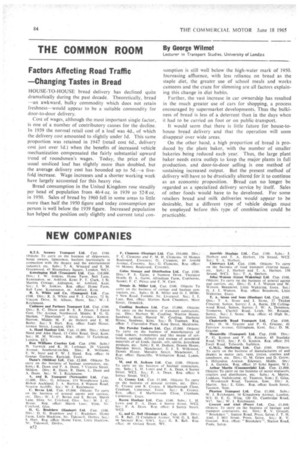THE COMMON ROOM
Page 86

If you've noticed an error in this article please click here to report it so we can fix it.
By George Wilmot
Lecturer in Transport Studies, University of London
Factors Affecting Road Traffic -Changing Tastes in Bread
HOUSE-TO-HOUSE bread delivery has declined quite dramatically during the past decade. Theoretically, bread -an awkward, bulky commodity which does not retain freshness-would appear to be a suitable commodity for door-to-door delivery.
Cost of wages, although the most important single factor, is one of a number of contributory causes for the decline. In 1939 the normal retail cost of a loaf was 4d., of which the delivery cost amounted to slightly under Id: This same proportion was retained in 1947 (retail cost 6d., delivery cost just over Id.) when the benefits of increased vehicle mechanization compensated the fairly substantial upward trend of roundsmen's wages. Today, the price of the usual unsliced loaf has slightly more than doubled, but the average delivery cost has bounded up to 5d.-a fivefold increase. Wage increases and a shorter working week have largely accounted for this heavy rise.
Bread consumption in the United Kingdom rose steadily per head of population from 46.4 oz. in 1939 to 52.8 oz. in 1950. Sales of bread by 1960 fell in some areas to little more than half the 1950 figure and today consumption per person is well below the 1939 figure. Increased population has helped the position only slightly and current total con sumption is still well below the high-water mark of 1950. Increasing affluence, with less reliance on bread as the staple diet, the greater use of school meals and works canteens and the craze for slimming are all factors explaining this change in diet habits.
Further, the vast increase in car ownership has resulted in the much greater use of cars for shopping, a process encouraged by supermarket developments. Thus the bulkiness of bread is less of a deterrent than in the days when it had to be carried on foot or on public ,transport.
It would seem that there is little future for house-tohouse bread delivery and that the operation will soon disappear over wide areas.
On the other hand, a high proportion of bread is produced by the plant baker, with the number of smaller bakeries being reduced each year. Thus, the large plant baker needs extra outlep to keep the major plants in full production, and door-to-door selling is one method of sustaining increased output. But the present method of delivery will have to be drastically altered for it to continue as an economic proposition. Bread can no longer be regarded as a specialized delivery service by itself. Sales of other foods would have to be develoned. For some retailers bread and milk deliveries would appear to be desirable, but a different type of vehicle design must be employed before this type of combination could be practicable.




































































































































